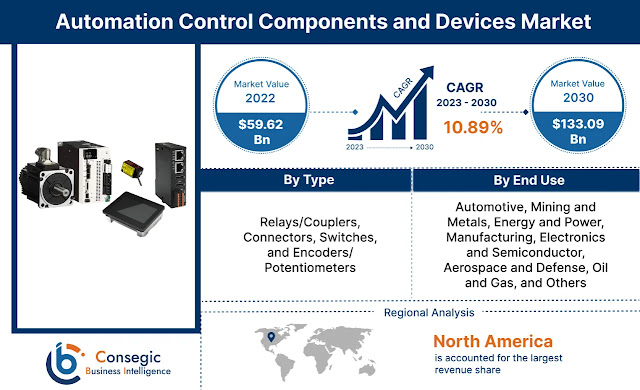Automation Control Components and Devices Market: Driving the Next Industrial Revolution
The Automation Control Components and Devices Market has emerged as the backbone of modern production systems. These components—ranging from relays and couplers to encoders and switches—are essential in enabling precision, consistency, and autonomy across critical industrial operations.
From automotive assembly lines to semiconductor fabrication plants, automation control devices ensure that production stays efficient, responsive, and safe. Their importance is amplified in today’s global climate, where the need for operational resilience, workforce augmentation, and digital integration is greater than ever.
Market Size and Growth Potential
In 2022, the Automation Control Components and Devices Market was valued at USD 59.62 billion. This figure is projected to climb to USD 133.09 billion by 2030, with a healthy compound annual growth rate (CAGR) of 10.89% between 2023 and 2030.
Based on current trends, the market is likely to surpass USD 150 billion by 2032 or 2033, indicating strong momentum in industrial automation investment. This growth signifies a broader industry commitment to smarter operations, fueled by advancements in Industry 4.0, AI-driven process control, and the growing adoption of cyber-physical systems in manufacturing.
Key Market Segments
By Type:
-
Relays/Couplers
-
Connectors
-
Switches
-
Encoders/Potentiometers
By End Use:
-
Automotive
-
Mining and Metals
-
Energy and Power
-
Manufacturing
-
Electronics and Semiconductor
-
Aerospace and Defense
-
Oil and Gas
-
Others
This segmentation reveals the versatility and depth of the market. While relays and switches dominate in traditional machinery, encoders and potentiometers are gaining traction in precision-driven sectors like aerospace, semiconductors, and robotics.
Key Players in the Market
Delta Electronics, Inc., Rockwell Automation, Inc., Emerson Electric Co., ABB Limited, Panasonic Corporation, Control Components, OMRON Corporation, Baumer Limited, Schneider Electric, Encoder Products Company, PHOENIX, AMETEK, Inc., LUTZE Inc., General Electric, Teledyne Technologies Incorporated, MKS Instruments, Honeywell International Inc., Siemens, Mitsubishi Electric Corporation
Market Trends and Drivers
Several powerful trends are shaping the future of automation control components:
-
Smart Manufacturing Boom: With global interest in Industry 4.0, companies are deploying more sensors, actuators, and feedback loops in their operations—driving demand for high-precision control components.
-
Energy Optimization and Safety: Governments and industries alike are emphasizing energy-efficient systems. Automation components like relays and switches now support smart grids and fail-safe power management.
-
Customization and Modularity: End users are increasingly looking for configurable and interoperable systems. This shift is pushing OEMs to develop modular components that seamlessly integrate into existing infrastructure.
-
AI and IoT Integration: Components are no longer passive. The convergence of AI and IoT has turned traditional automation parts into intelligent nodes capable of predictive diagnostics and autonomous correction.
Regional Insights
Asia-Pacific
This region leads the global market, driven by large-scale manufacturing hubs in China, Japan, South Korea, and India. Strong governmental support for industrial modernization and growing demand for localized production are accelerating automation investments here.
North America
Known for innovation and high-tech manufacturing, North America is embracing automation to drive productivity amid labor shortages and rising operational costs. The U.S. in particular is seeing rapid adoption in automotive and electronics sectors.
Europe
Europe’s strength lies in its eco-conscious approach and precision engineering. Countries like Germany, France, and the Netherlands are investing heavily in smart factories and sustainable industrial systems.
Latin America & Middle East & Africa
These regions are emerging as fast-growth zones due to increased urbanization, infrastructure development, and global supply chain diversification. There’s rising interest in energy-efficient automation across oil and gas, mining, and utility sectors.
Forecast and Outlook
Looking ahead to 2032 and beyond, the Automation Control Components and Devices Market is poised for robust transformation. Innovations will focus on miniaturization, wireless connectivity, and real-time monitoring. The rise of edge computing and AI-enabled systems will further enhance component intelligence, making them integral to adaptive and resilient manufacturing ecosystems.
Conclusion
The Automation Control Components and Devices Market is no longer just a facilitator of basic mechanical operations—it is now central to digital transformation, operational excellence, and competitive advantage. For businesses, manufacturers, and investors alike, this market offers not only strong growth potential but also an opportunity to lead in the next wave of industrial progress.
As companies reimagine how they build, power, and manage their processes, automation components are becoming both a strategic asset and a symbol of future‑ready infrastructure. This is a space to watch—and invest in.



Comments
Post a Comment